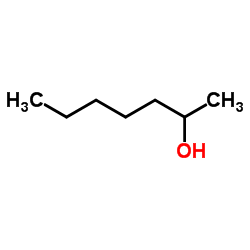2-Heptanol

2-Heptanol structure
|
Common Name | 2-Heptanol | ||
|---|---|---|---|---|
| CAS Number | 543-49-7 | Molecular Weight | 116.201 | |
| Density | 0.8±0.1 g/cm3 | Boiling Point | 159.4±3.0 °C at 760 mmHg | |
| Molecular Formula | C7H16O | Melting Point | N/A | |
| MSDS | Chinese USA | Flash Point | 64.4±0.0 °C | |
| Symbol |


GHS02, GHS07 |
Signal Word | Warning | |
Use of 2-Heptanol2-Heptanol is one of chemical constituents identified in the essential oil of rhizome of Curcuma angustifolia and Curcuma zedoaria. Rhizome essential oil exhibited good antimicrobial and antioxidant activity[1]. |
| Name | 2-Heptanol |
|---|---|
| Synonym | More Synonyms |
| Description | 2-Heptanol is one of chemical constituents identified in the essential oil of rhizome of Curcuma angustifolia and Curcuma zedoaria. Rhizome essential oil exhibited good antimicrobial and antioxidant activity[1]. |
|---|---|
| Related Catalog | |
| References |
| Density | 0.8±0.1 g/cm3 |
|---|---|
| Boiling Point | 159.4±3.0 °C at 760 mmHg |
| Molecular Formula | C7H16O |
| Molecular Weight | 116.201 |
| Flash Point | 64.4±0.0 °C |
| Exact Mass | 116.120117 |
| PSA | 20.23000 |
| LogP | 2.29 |
| Vapour Pressure | 0.9±0.6 mmHg at 25°C |
| Index of Refraction | 1.421 |
| InChIKey | CETWDUZRCINIHU-UHFFFAOYSA-N |
| SMILES | CCCCCC(C)O |
| Stability | Stable. Flammable. Incompatible with strong oxidizing agents, strong acids. |
| Water Solubility | 0.35 g/100 mL |
CHEMICAL IDENTIFICATION
HEALTH HAZARD DATAACUTE TOXICITY DATA
|
| Symbol |


GHS02, GHS07 |
|---|---|
| Signal Word | Warning |
| Hazard Statements | H226-H312 |
| Precautionary Statements | P280 |
| Personal Protective Equipment | Eyeshields;Faceshields;full-face respirator (US);Gloves;multi-purpose combination respirator cartridge (US);type ABEK (EN14387) respirator filter |
| Hazard Codes | Xn:Harmful; |
| Risk Phrases | R21;R36 |
| Safety Phrases | S36/37-S36/37/39-S26 |
| RIDADR | UN 1987 3/PG 3 |
| WGK Germany | 3 |
| RTECS | MJ2975000 |
| Packaging Group | III |
| Hazard Class | 3 |
| HS Code | 29051900 |
| HS Code | 29051900 |
|---|
|
Evaluation of injection methods for fast, high peak capacity separations with low thermal mass gas chromatography.
J. Chromatogr. A. 1392 , 82-90, (2015) Low thermal mass gas chromatography (LTM-GC) was evaluated for rapid, high peak capacity separations with three injection methods: liquid, headspace solid phase micro-extraction (HS-SPME), and direct ... |
|
|
Circuit formation and function in the olfactory bulb of mice with reduced spontaneous afferent activity.
J. Neurosci. 35(1) , 146-60, (2015) The type of neuronal activity required for circuit development is a matter of significant debate. We addressed this issue by analyzing the topographic organization of the olfactory bulb in transgenic ... |
|
|
Characterization of Volatile Flavor Compounds in Chinese Rice Wine Fermented from Enzymatic Extruded Rice.
J. Food Sci. 80 , C1476-89, (2015) Enzymatic extrusion, instead of traditional steam cooking, to treat rice is an efficient and alternative pretreatment for Chinese rice wine fermentation. In order to determine the formation of volatil... |
| methyl-n-amyl-carbinol |
| QY5&1 |
| Methyl amyl carbinol |
| methyl-hexanol |
| Heptan-2-ol |
| UNII-E12FIG07JK |
| Heptyl alcohol, sec- |
| s-Heptyl alcohol |
| rac-2-heptanol |
| Amyl methyl carbinol |
| EINECS 208-844-3 |
| 2-Hydroxyheptane |
| 1-Methylhexanol |
| 2-Heptyl alcohol |
| MFCD00004587 |
| 2-Heptanol |
| methylhexanol |
| 3-Fluoronorepinephrine |

